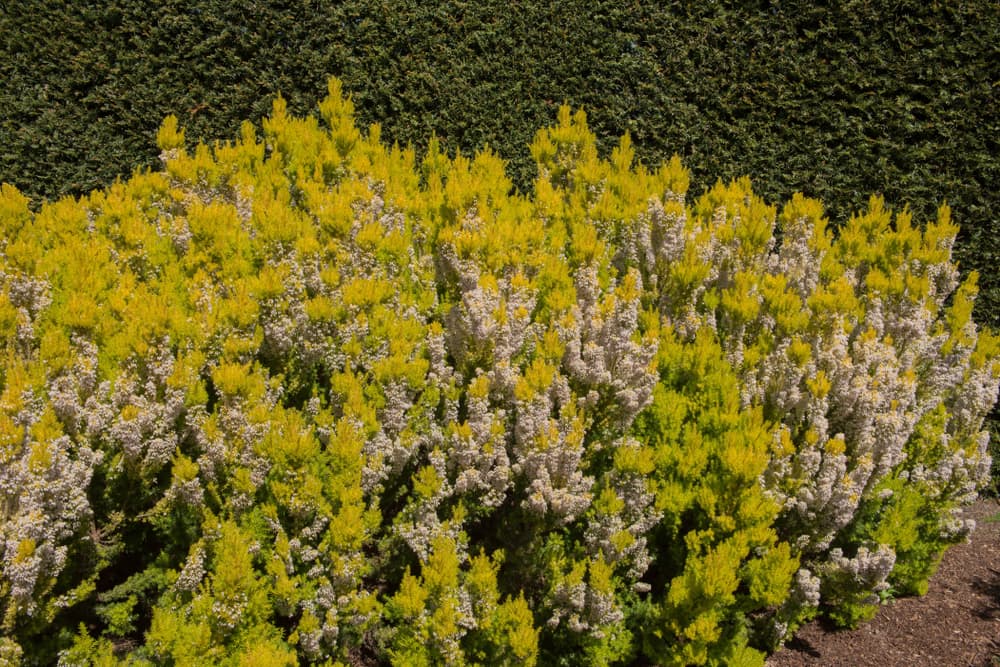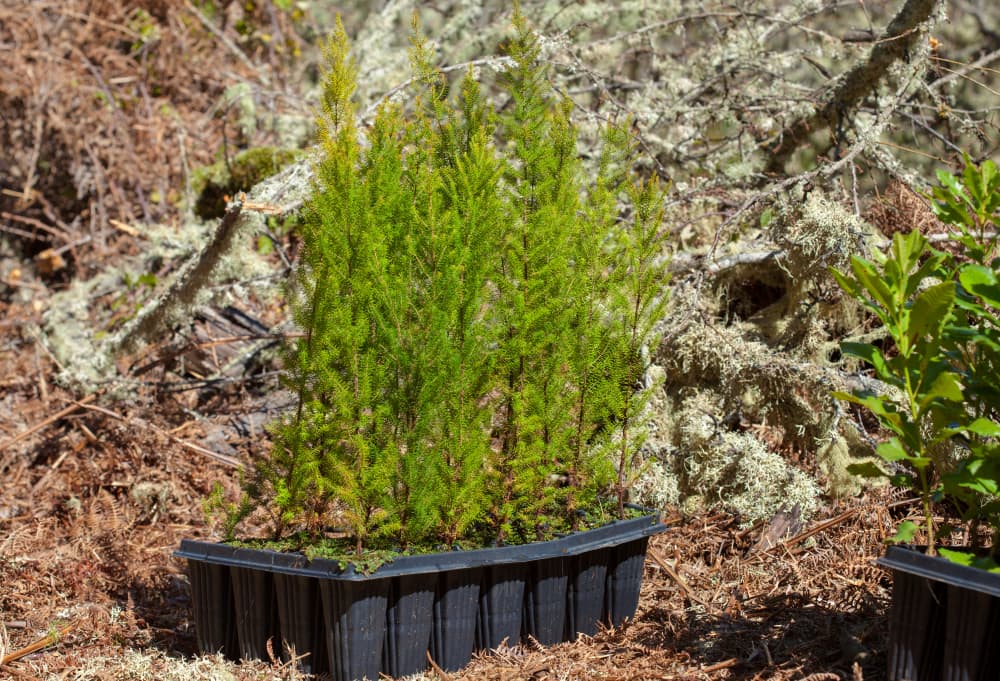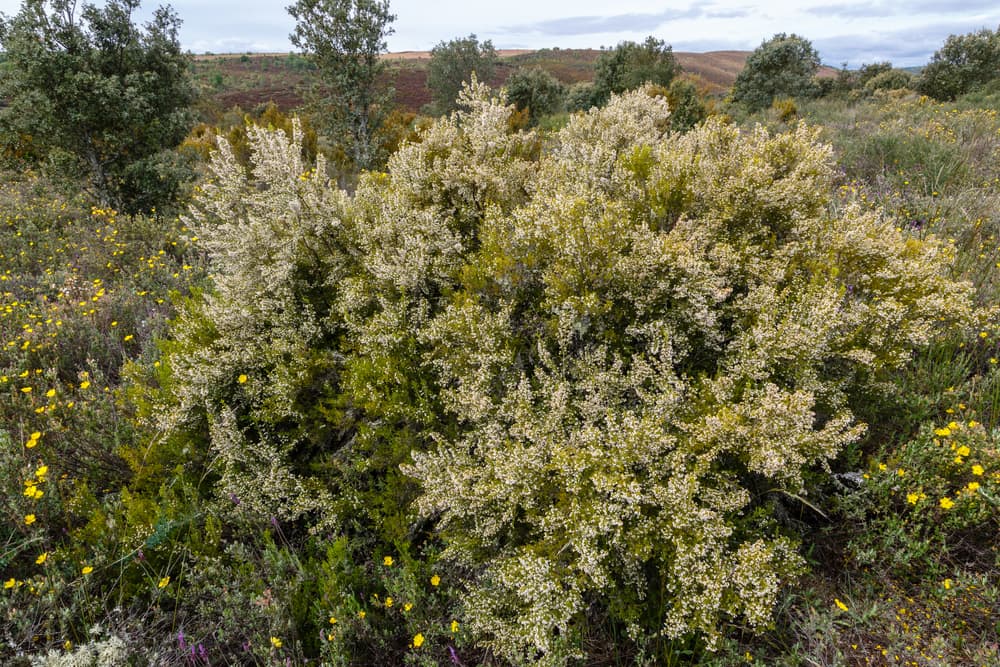HEATHERS > TREE-HEATHER
Chris is a gardening writer and nature enthusiast. He graduated from Oxford Brookes University in 2022 with an MA in Psychology. Chris works with the Leeds Green Action Society, helping their food cooperative by growing various fruit and vegetables on their two allotments in Hyde Park, Leeds.
Reviewed By COLIN SKELLY

Colin is a Horticulturist and Horticultural Consultant with experience in a range of practical and managerial roles across heritage, commercial and public horticulture. He holds the Royal Horticultural Society’s Master of Horticulture award and has a particular interest in horticultural ecology and naturalistic planting for habitat and climate resilience.
IN THIS GUIDE
HEATHER GUIDES
Container Growing
Pruning
Rejuvenation
Tree Heather
There’s heather, then there’s tree heather. And although the names are similar, the two plants are very different in terms of appearance and habit.
Whereas heather keeps a low profile and bursts forth in an exciting array of pinks and purples, tree heather cultivars riff on a theme that’s close to our stereotypical expectation of what an evergreen should look like: proud, green, and angular.
Between the varieties available you can find some truly astounding specimens, at home in any garden.

Tree heather, also called tree heath (a useful way to distinguish it from regular old heather) goes by the Latin name of Erica arborea.
It’s an evergreen, and the family includes shrubs and small trees.
Overview
| Botanical Name | Erica arborea |
| Common Name(s) | Tree Heather |
| Plant Type | Shrub / Hedging |
| Native Area | Southern Europe, North Africa, Central & Eastern Africa |
| Hardiness Rating | H4 |
| Foliage | Evergreen |
| Flowers | Small fragrant white flowers in long panicles |
| When To Sow | March, April, September, October |
| Flowering Months | February, March, April, May |
| When To Prune | May, June |
Sunlight
Preferred
Full Sun
Exposure
Exposed or Sheltered
Size
Height
1.5 – 2.5M
Spread
0.5 – 1M
Bloom Time
February – May
Soil
Preferred
Clay, loam, sand
Moisture
Moist but well drained
pH
Neutral / Acidic
The plant originally hails from various parts of Africa and Southern Europe, but has now become naturalised in other parts of the world.1Erica arborea. (n.d.). Kew Royal Botanic Gardens. Retrieved March 14, 2023, from https://powo.science.kew.org/taxon/urn:lsid:ipni.org:names:328204-1
It’s popular as an ornamental plant in British gardens thanks to the aesthetic variety on offer.
Why Grow Tree Heather?
Tree heather is a hardy and attractive plant with varieties coming in a wide range of shapes and sizes.
If you’re looking for something to bring a little visual interest to your garden, and you’re attracted to the general evergreen aesthetic, then tree heather could be right up your street.
Tree heather wood – also called briar – is also incredibly hard, and lends itself excellently to woodworking.
Tree Heather Varieties
Here are three varieties that showcase the best the plant has to offer.
These cultivars have all been awarded the Royal Horticultural Society’s Award of Garden Merit (AGM), indicating that they are well suited to growing in the UK.
E. arborea ‘Albert’s Gold’

In our opinion, ‘Albert’s Gold’ aligns most closely with the image that comes to mind when someone mentions evergreen trees.
It boasts triangular fronds of light green leaves, with spikes that carve a space for themselves in your field of vision.
They’re like a scaled-down version of the enormous fir trees you’d expect to see in a rugged Canadian landscape.
E. arborea ‘Alpina’

‘Alpina’ shares many visual characteristics with ‘Albert’s Gold’, except the leaves generally weigh in quite a bit darker on the green spectrum.
Grown together with ‘Albert’s Gold’, ‘Alpina’ showcases the rich variety of colours offered by tree heather.
Grown alone, it’s another way to capture and replicate the rugged flora that can be hard to achieve in UK gardens.
E. arborea ‘Estrella Gold’

‘Estrella Gold’ is a little daintier, compared to the rugged varieties we’ve shown already.
Each leaf has a small white centre, creating a speckled, almost snow-like effect when seen from afar.
This cultivar also grows to a far smaller maximum height than Albert’s Gold and Alpina, demonstrating the versatility available between the different types.
How To Grow Tree Heather
Generally speaking, tree heather is hardy and sturdy; being able to take whatever British climate sees fit to throw at it.
There are many things you can do to give your plants the best chance at a long and healthy life, however.
Where To Grow
Choose a spot with acidic soil that can drain freely.
Soil that retains moisture, or is neutral or alkali, will stifle or even kill off further tree heather growth.

This plant likes full sun or partial shade, and will do well growing under the canopy of a bigger tree.
In fact, the shelter offered by another tree will promote better growth because, while hardy, E. arborea prefers not to be fully exposed to the elements.
Planting
Tree heathers are grown from younger plants, rather than from seed.
Planting yours out is simply a case of finding the right spot in your garden (see the next section), and taking the following steps.
First, dig a hole a couple of times wider than your rootball, to a depth that allows the top of the rootball to align with the soil surface.
Next, remove your well-watered plant from its pot, tease apart the roots from the clumped root ball and plonk it into the hole.

Depending on the variety you’re growing, you may want to place a stake at this stage.
This is a structure made of wood or similar that provides support for the growing plant, making up for the strength that the root system would provide to a fully-established plant.
Finally, fill in the hole, ensuring that the soil is packed down tightly enough to fill air pockets, but not so tightly that you crush the plant.
Tree Heather Care
Feeding
When planting out your tree heather, we advise working a few centimetres of compost well into the soil in the area your plant will go.
Be generous with the compost, taking into account the eventual size of the mature plant.
Enriching the soil with nutrients early on will give the developing root system the best possible shot at getting what it needs to grow big and strong.
Watering
With evergreens, you need to stay vigilant.
In the first season, check in often to see whether the roots are moist.

You’ll want to keep them well-watered to promote the strongest growth.
Then, through winter, you need to take into account the water lost through the leaves – much more of a consideration for evergreens than other plant types.
Keeping your tree heather well-watered throughout the year, rather than waiting for it to show signs of thirst before watering, will best set you up for success.
Pruning
As a shrub, tree heather will do well with regular annual pruning to keep it in shape.
The best time of year to do this is late spring: after the frosts that may damage freshly cut areas, and with enough time to allow new growth to cover up most of the visual evidence of pruning.
This said, however, pruning isn’t required to keep the plant alive – tree heather falls into RHS Pruning Group 8, meaning it can do without.2Shrubs: pruning evergreens. (n.d.). Royal Horticultural Society. Retrieved March 14, 2023, from https://www.rhs.org.uk/plants/types/shrubs/evergreen-pruning-guide

If you do decide to prune, do so after flowering.
Remove any diseased or damaged shoots, and then thin out sections that may have become crowded.
“Tree heathers can become straggly, especially if not annually pruned,” shares Master Horticulturist Colin Skelly.
“Branches can be pruned back to around 30cm from ground height if required after flowering.
“Plants will respond by putting on fresh growth, which should be tip-pruned to develop bushy growth.”
Common Problems
Tree heather is a hardy plant that’s not likely to attract any pests or prove particularly problematic.
The most likely issue is a thirsty plant struggling to thrive, but if you follow the steps in the watering section, you should be able to control against that.
Phytophthora Root Rot
No, that’s not a typo.
Phytophthora is a species of fungus that can wreak havoc on the roots of certain tree heather varieties.
Rot caused by phytophthora is hard to distinguish from that caused by overly-moist soil – over time, rot reduces the roots’ ability to draw nutrients from the soil, leading to wilting, discolouration, and general poor health.
Unfortunately, once you see symptoms above ground, things are usually too far gone below ground to salvage the plant.

Keeping soil well-drained to control against rot caused by waterlogging should help you be more certain that any rot you do encounter is Phytophthora.
In this instance, you need to remove and destroy the plant, then to replace the topsoil in the affected area.
While drastic, this is the best solution in ensuring that future outbreaks do not occur.
Whether you go for the forest-in-miniature ‘Albert’s Gold’, the daintier and more delicate ‘Alpina’, or one of the many other E. arborea varieties, tree heather is sure to make a good impression.
We can assure you that you won’t look back, whatever the heather.
References
- 1Erica arborea. (n.d.). Kew Royal Botanic Gardens. Retrieved March 14, 2023, from https://powo.science.kew.org/taxon/urn:lsid:ipni.org:names:328204-1
- 2Shrubs: pruning evergreens. (n.d.). Royal Horticultural Society. Retrieved March 14, 2023, from https://www.rhs.org.uk/plants/types/shrubs/evergreen-pruning-guide

